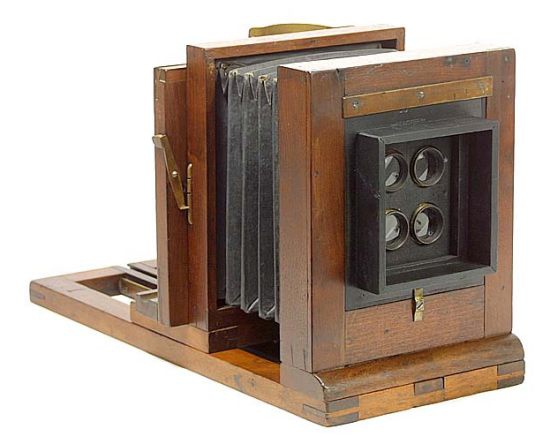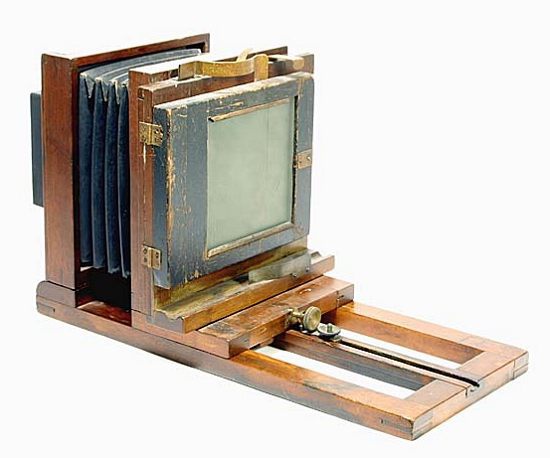|
|




Copyright ©2002 by Rob Niederman - ALL RIGHTS RESERVED
Return to the Multiple Lens Cameras page
John Stock, a former cabinet maker, is one of the
earliest American builders. He joined the market during
the 1850s (c.1857 - 58) along with a group of
legendary builders including Henry J. Lewis, George
Chapman, E. Gordon as well as opticians Holmes,
Booth & Haydens and Harrison Optical Company.
Stock's advertisements listed Camera Boxes, plateholders, glass baths and ambrotype equipment.
In 1864, Stock came together with the lens maker C.C. Harrison and was later acquired by the American Optical Company in 1866 along with Nelson Wright.
Most any Stock camera is a rare find, especially examples made before the purchase by the American Optical Co.
According to Bill Marder in his book Anthony, the MAN, the COMPANY, the CAMERAS, cameras manufactured by John Stock & Company were similar to the few cameras from this period which are stamped with "Anthony - New York".
Camera Box with 4-tube gem lens set; 4-1/2 x 5-1/2 inch daguerreotype half plate format.
Stock's advertisements listed Camera Boxes, plateholders, glass baths and ambrotype equipment.
In 1864, Stock came together with the lens maker C.C. Harrison and was later acquired by the American Optical Company in 1866 along with Nelson Wright.
Most any Stock camera is a rare find, especially examples made before the purchase by the American Optical Co.
According to Bill Marder in his book Anthony, the MAN, the COMPANY, the CAMERAS, cameras manufactured by John Stock & Company were similar to the few cameras from this period which are stamped with "Anthony - New York".
Camera Box with 4-tube gem lens set; 4-1/2 x 5-1/2 inch daguerreotype half plate format.
Multi-Lens Cameras | View Cameras | Self-Casing Cameras | Solid Body Cameras | References & Advertisements
Home | What's New | Show Schedule | Wanted | For Sale | Links | Site Map | Email
Home | What's New | Show Schedule | Wanted | For Sale | Links | Site Map | Email
After the 1866 acquisition, the large brass wetplate retaining hardware on Stock cameras is found with the marking: John Stock's
Patented, May 31, 1864 - assigned to Am. Optical Company. The camera shown on this webpage was built after the acquisition and has
the "assigned to" designation as well as Am. Optical Company impressions at the rear corners of the rails.
This particular Camera Box has dove-tail construction details (very unusual for an American camera - but also found on the Gordon Tailboard Camera), a rise-fall multiplying back, and a wetplate holder with brass registration hardware for side-to-side movements. These cameras were normally sold with a single portrait lens but 4-tube gem lens options were also available.
The heavy construction is very evident, which includes a collodion drip trough below the ground glass assembly. The body is constructed of dove-tails. Other examples of Stock cameras have box joint construction details.
This particular Camera Box has dove-tail construction details (very unusual for an American camera - but also found on the Gordon Tailboard Camera), a rise-fall multiplying back, and a wetplate holder with brass registration hardware for side-to-side movements. These cameras were normally sold with a single portrait lens but 4-tube gem lens options were also available.
The heavy construction is very evident, which includes a collodion drip trough below the ground glass assembly. The body is constructed of dove-tails. Other examples of Stock cameras have box joint construction details.
The 1866 acquisition announcement included a
bit of PR from American Optical to let the public
know about the disposition of Stock's patents
and quality of construction.
The Patents for all of which we have purchased.
The high character of these goods have enjoyed
shall be fully maintained. The Camera Boxes will
always be true, easy in working, of great
DURABILITY and LIGHTNESS ; no conceivable
quality will be wanting to make them perfect, and
well adapted to produce the best possible results
in taking pictures. The profession have suffered
too much with inferior apparatus not to appreciate
the advantages of ours-always reliable in all
weather and in all climates. We cannot, in the
advertisement, give a description of our goods. An
Illustrated Catalogue will soon be issued, giving
minute description, also prices (which have been
carefully revised and made as low as possible,
consistent with the quality of the goods) ; these
will be forwarded to everyone who will give their
name and address. Orders filled promptly ; goods
carefully packed and delivered to Express Co. free
of charge. Address, AMERICAN OPTICAL CO.,
458 Broadway, New York.
Multiplying Camera Box, late 1860s
John Stock & Company, NY.
John Stock & Company, NY.